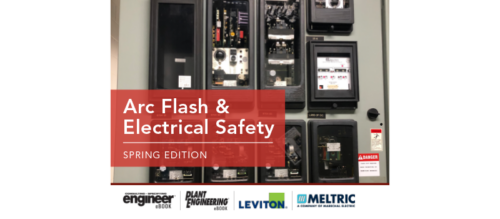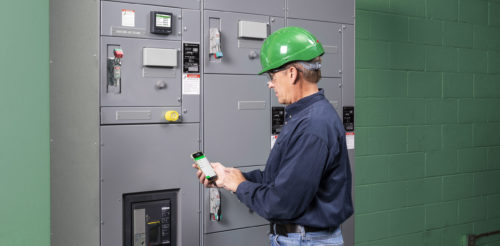Complying with new electrical safety regulations
A major National Electric Code change that affects industrial control panels becomes enforceable in January 2005. On the surface, it appears that the change affects only OEMs and panel builders. However, because completed industrial control panels make their way to your plant, you need to know how this change affects you.
Key Concepts
Industrial control panels must now be labeled with short-circuit current ratings.
Although the Code change affects OEMs and panel shops primarily, it also affects your plant.
NFPA-70E-2004 110.7 says that facilities must establish and maintain an electrical safety program
Sections: Regulations and standards What is SCCR? Industrial control panels How this Code change affects you More Info:
Sidebars: Tips for establishing and maintaining a safety program
A major National Electric Code change that affects industrial control panels becomes enforceable in January 2005. On the surface, it appears that the change affects only OEMs and panel builders. However, because completed industrial control panels make their way to your plant, you need to know how this change affects you.
The 2005 NEC requires those who construct industrial control panels to label them with their short-circuit current ratings (SCCRs), which facilitates the inspection and approval processes. This article explains the applicable requirements of UL-508 and 2005 NEC Article 409, which specifically apply to SCCR of industrial control panels (Fig. 1).
SCCR labels on components and equipment make it easier for inspectors to verify proper protection for specific applications. These standards are applicable to initial installations as well as relocation of equipment. According to the new Code version, the “SCCR for a component or equipment shall be equal to or greater than the available short-circuit current where the equipment is being installed in the system.”
Regulations and standards
A regulation is a requirement; a standard is a reference to which some regulations refer to facilitate understanding or provide clarification to technical or procedural points (Fig. 2). The Occupational Safety and Health Administration (OSHA) publishes and enforces regulations. National Fire Protection Association (NFPA) produces standards. OSHA refers to a growing number of NFPA standards — including the National Electric Code (NEC) — to enforce its regulations.
When OSHA gets involved, it’s usually because an incident has occurred. Plants that make electrical safety a priority know and understand what OSHA requires, and are proactive when it comes to adopting ongoing changes to the NEC. These proactive plants have already established, and are maintaining electrical safety programs (see “Tips for establishing and maintaining an electrical safety program”).
The inspectors that certify your plant are licensed by the state. Each state in the U.S. is responsible for adopting versions of the NEC for use by its inspectors. On a state level (which automatically brings it to the plant level), when a certain NEC version is adopted, it becomes law in that state, because that is what the inspector uses as certifying authority.
What is SCCR?
Short-circuit current rating is not the same as interrupt rating, and it is important to know the difference. Interrupt rating is the maximum short-circuit current a fuse or circuit breaker can safely interrupt under standard test conditions; it does not ensure protection of the circuit components or equipment. Adequate interrupting rating is required per NEC 409.110.9.
Short-circuit current rating is the maximum short-circuit current a component or equipment can safely withstand when protected by a specific overcurrent protective device or for a specified time interval . Adequate SCCR is required per NEC 409.110.10. SCCR pertains to protection of components, multiple component assemblies, or entire control panels.
Marked SCCRs are important, because not only are they required to ensure compliance with NEC 110.10, but they simplify the inspection and approval process, and they help eliminate hazards where components and equipment are applied above their ratings. A potential hazard exists where higher fault currents are available.
Industrial control panels
The new Article 409 in the 2005 NEC is titled Industrial Control Panels . There are specific requirements for industrial control panels, which have not been regulated significantly — until now. These control panels are used in many places throughout industrial plants to control machines and processes. Many panels are one-of-a-kind.
According to George Gregory, P.E., manager, industry standards, Schneider Electric, Cedar Rapids, IA, before NFPA introduced Article 409, Underwriters Laboratories, Inc., had introduced UL 508A — its first edition dated April 2001. UL 508A began to apply an added degree of regulation to those panels that were third-party listed or certified. However, many panels were not listed because they were not specifically covered by the NEC, or were part of machines or equipment that were upgraded or retrofitted after the initial installation. With the introduction of NEC Article 409, inspectors will examine industrial control panels with increased scrutiny.
A major addition to both UL 508A and NEC Article 409 is the new SCCR on industrial control panels. The requirement for an SCCR in NEC 409.110 states:
An industrial control panel shall be marked with the following information that is plainly visible after installation: (3) Short circuit current rating of the industrial control panel based on one of the following:
(a) short circuit current rating of a listed and labeled assembly
(b) short circuit current rating established using an approved method.
FPN: UL 508A-2001 Supplement SB is an example of an approved method.
This requirement for SCCR labeling of industrial control panels is effective when the 2005 NEC is adopted in each jurisdiction, which is enforced at the state level — effective early in 2005 for much of the U.S.
The UL 508A requirements for SCCR appear in its Supplement SB . These requirements are adopted and will be enforced as an effective requirement in April 2006. However, for a listed industrial control panel to be marked with an SCCR to comply with the NEC, it will have to be evaluated for that rating under the adopted requirements of Supplement SB.
The ways that an OEM, machine builder, or panel builder obtains an SCCR for a panel include:
Test each construction in the specified short-circuit test sequence
Purchase components from a specific manufacturer that has already tested component combinations and documented the results
Apply the evaluation method of Supplement SB by which the panel builder or OEM assures that each component has an SCCR and applies the lowest rating of any component as the rating of the panel.
Generally, components used in the control circuit or components that are not in the primary circuit, such as pilot lights and PLCs, will not have to have individual SCCRs. Only the components in the electrical power distribution path must bear the SCCR rating.
For example, if a panel at your plant includes components such as circuit breakers, a motor control, and a starter, the lowest rated SCCR of these components must be used to label the panel (Fig. 3). If the SCCRs were obtained from the component manufacturer, a simple scenario is:
Circuit breaker SCCR — 25 kA
Motor control SCCR — 15 kA
Starter SCCR — 5 kA.
The panel’s overall short circuit current rating is 5 kA based on the lowest-rated component. Another procedure is to use a group of components that have been tested in combination to the specified SCCR.
How this Code change affects you
Although the Code change affects OEMs, machine builders, and panel shops in a big way, it also affects your plant. The following list includes some of the points you should consider:
Inspectors will be looking more carefully at new or updated installations for listed panels with an SCCR
When ordering machines, equipment, or panels, you must specify listed and labeled panels — even though you may not have made this specification in the past
As equipment is moved within the plant or from plant to plant, you must ensure that the SCCR of your panels are adequate for each location
Individual state regulations have requirements in place to ensure that control panels and industrial equipment meet the NEC and appropriate standards when equipment is moved from one plant to the next — therefore certain retrofit issues may arise
As components are replaced within a panel, the impact of the replacement part on the SCCR of the panel must be considered
As plants perform arc flash analyses, machinery and panels must be considered. Although this is not a change, with the emergence of Article 409, there will be a greater sensitivity to these analyses by plants and those performing the analyses.
If an overcurrent situation arises, the energy level may be higher than the lowest level SCCR on a component within the panel. When ratings on components are less than the available fault current, the safe performance of the panel comes into question. Further evaluation of the panel and component combinations may be necessary to ensure a safe electrical installation.
More Info:
PLANT ENGINEERING magazine extends its appreciation to Cooper Bussmann, NFPA, and Schneider Electric for their assistance in the preparation of this article. For more information about these and other standards and regulations go to nfpa.org , osha.gov , ul.com , and plantengineering.com .
On January 27, 2005, PLANT ENGINEERING magazine will present a webcast titled “New directions in electrical safety.” (Visit plantengineering.com to register for this free webcast)
Tips for establishing and maintaining a safety program
NFPA-70E-2004 110.7 says that facilities must establish and maintain an electrical safety program. But with more work to do than there is time to do it, how can a safety program fit in? The following list offers some tips on how to get started:
Designate a champion — Make someone responsible for ensuring Code compliance. This person should be empowered with the authority and resources to follow through. This person must be a champion — not a scapegoat.
Know the Code — The internal champion at your plant should become familiar with the version of the NEC that is in effect in your state. When the Code changes, he or she should be aware of what those changes are to ensure compliance.
Involve everyone — Electrical safety is not just the job of the safety guru — it’s the job of everyone who works with electricity.
Update electrical documentation — Establishing and maintaining an electrical safety program requires that the electrical documentation for your plant be accurate. If your electrical one line diagram is not accurate, that’s a good place to start.
Communicate — Electrical safety is not just for the elite few. Communicate safety procedures, updates, and changes to those affected.
Make electrical safety a priority — How safe are your plant’s electrical workers if safety is at the bottom of the priority list?
Keep current — It has been said that the only constant is change. The NEC is a prime example of change. If there is a standard or regulation that affects the safe operation of your plant, it is your responsibility to know it and ensure compliance.
Identify key information sources — If you invest the resources to establish or overhaul your electrical safety program, it makes sense to stay on top of ever-changing requirements, codes, and best practices.
Organizations such as NFPA, IEEE, and OSHA publish standards and regulations, as well as maintain websites. Requesting proceedings, standards, and updates provides first-hand knowledge of changes that affect your plant. Reading trade publications, such as PLANT ENGINEERING magazine, helps you stay on top of changes, and lets you know what’s important.
Do you have experience and expertise with the topics mentioned in this content? You should consider contributing to our CFE Media editorial team and getting the recognition you and your company deserve. Click here to start this process.




